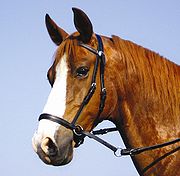.gif)
Robert Cook (veterinarian)
Encyclopedia
Robert Cook has published many papers, mainly on diseases of the horse's mouth, ear, nose and throat both in scientific and horseman's journals, covering both various topics:
 In 1997 Dr. Cook met Edward Allan Buck, inventor of the 'original' bitless bridle in Del Mar, CA. Subsequent to that meeting Dr. Cook wrote articles and many letters regarding the bitless bridle. Dr. Cook then took the original design created by Edward Allan Buck and began presenting it as his own
In 1997 Dr. Cook met Edward Allan Buck, inventor of the 'original' bitless bridle in Del Mar, CA. Subsequent to that meeting Dr. Cook wrote articles and many letters regarding the bitless bridle. Dr. Cook then took the original design created by Edward Allan Buck and began presenting it as his own
Since 1997, his main interest is the disadvantages, and problems associated with using a bit in a horse's mouth. He proposes that bit is the direct cause of many behavioural problems and diseases of the horse, and that it exposes both the horse and the rider to serious risk; he concluded that bit is contraindicated, counterproductive and, in the wrong hands, potentially cruel http://www.bitlessbridle.com; he studied a new, patented type of bitless bridle
, and he is now collecting more scientific evidence about its use and about related prevention of important horse problems and diseases.
- equine diagnostical and surgical endoscopyEndoscopyEndoscopy means looking inside and typically refers to looking inside the body for medical reasons using an endoscope , an instrument used to examine the interior of a hollow organ or cavity of the body. Unlike most other medical imaging devices, endoscopes are inserted directly into the organ...
; - pulmonary origin of the "nose-bleeds" in racehorses (EIPH: Exercise induced pulmonary hemorrhageExercise Induced Pulmonary HemorrhageExercise induced pulmonary hemorrhage , also known as "bleeding" or a "bleeding attack", refers to the presence of blood in the airways of the lung in association with exercise. EIPH is common in horses undertaking intense exercise, but it has also been reported in human athletes, racing camels and...
) and its relation with recurrent airway obstructionRecurrent Airway ObstructionRecurrent airway obstruction, also known as broken wind, heaves, or sometimes by the term usually used for humans , is a respiratory disease in horses... - anatomy and physiology of horse's upper airway;
- guttural pouchGuttural pouchIn the equids and some rodent-like species such as the desert hyrax, the guttural pouch is a pair of air chambers in the neck just behind the skull and below the ears...
diseases - epiglottic entrapment
- stride and respiration
- recurrent laryngeal neuropathy (RLN)
- dorsal displacement of the soft palate
- laryngo-palatal dislocation
- headshaking syndromeHeadshakingHeadshaking is a condition where the horse or pony shakes its head continuously, often while being ridden.Originally considered a bad habit, it is now thought that some horses are allergic to certain pollens, which causes them to headshake. However horses also normally react to flies, and...
and its relations with bit-related trigeminal neuralgia - physiological incompatibilities of a bit in the mouth of a working horse
- role of the bit in the soft palate paresis at exercise and in asphyxia-induced pulmonary hemorrhage (EIPH)

Since 1997, his main interest is the disadvantages, and problems associated with using a bit in a horse's mouth. He proposes that bit is the direct cause of many behavioural problems and diseases of the horse, and that it exposes both the horse and the rider to serious risk; he concluded that bit is contraindicated, counterproductive and, in the wrong hands, potentially cruel http://www.bitlessbridle.com; he studied a new, patented type of bitless bridle
Bitless bridle
A bitless bridle is a general term describing a wide range of headgear for a horses or other animals that controls the animal without placing a bit in the animal's mouth. Control is maintained by means of some sort of noseband or cavesson. The term hackamore is the most historically accurate word...
, and he is now collecting more scientific evidence about its use and about related prevention of important horse problems and diseases.

